


DONATO BRAMANTE 1444 -
Including:
Pope Julius II
and the
Sforza family

xxxxxBramante was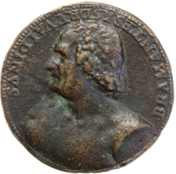 born near Urbino, and it was probably in this city that he received his training, first as a painter and then as an architect in the workshops of the Ducal Palace. He moved to Milan in the late 1470s, where he worked for the new duke, Ludovico Sforza. Notable here was his enlargement of two churches, Santa Maria presso San Satiro and Santa Maria della Grazie. In the first, he overcame a limited site by constructing a false choir at the end of the nave in order to give the appearance of greater depth, a device used for the first time. In the second, his building of the choir and cupola was influenced by the classical style of the Florence Renaissance, but his floor plans and decoration were reminiscent of Byzantine design.
born near Urbino, and it was probably in this city that he received his training, first as a painter and then as an architect in the workshops of the Ducal Palace. He moved to Milan in the late 1470s, where he worked for the new duke, Ludovico Sforza. Notable here was his enlargement of two churches, Santa Maria presso San Satiro and Santa Maria della Grazie. In the first, he overcame a limited site by constructing a false choir at the end of the nave in order to give the appearance of greater depth, a device used for the first time. In the second, his building of the choir and cupola was influenced by the classical style of the Florence Renaissance, but his floor plans and decoration were reminiscent of Byzantine design.
xxxxxIt was while in Milan that Bramante became a close associate of Leonardo da Vinci. They had met when Leonardo had travelled from Florence in 1482, and later both men worked together trying to solve a structural problem in Milan cathedral. Later, in 1493, Bramante visited Florence to study the works of Brunelleschi.
xxxxxWith the fall from power 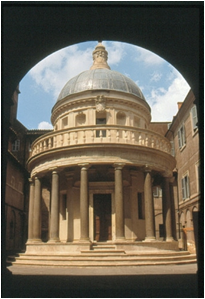 of
of 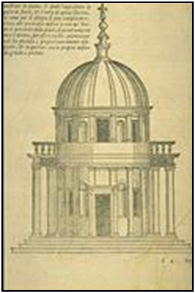 Ludovico Sforza in 1499, Bramante left for Rome, and it was here that he lived and worked for the rest of his life. Once settled in, he became deeply inspired and influenced by the impressive, imposing monuments of ancient Rome, a fact clearly to be seen in his first major work here, the Tempietto (illustrated together with plan). Built in the courtyard of the church of Santa Pietro in Montorio -
Ludovico Sforza in 1499, Bramante left for Rome, and it was here that he lived and worked for the rest of his life. Once settled in, he became deeply inspired and influenced by the impressive, imposing monuments of ancient Rome, a fact clearly to be seen in his first major work here, the Tempietto (illustrated together with plan). Built in the courtyard of the church of Santa Pietro in Montorio -
xxxxxThe coming in 1503 of the new pope, Julius II, with his ambitious plans for Rome, brought new opportunities for Bramante. Appointed architect and town planner, he widened roads, constructed large squares, and improved the port facilities. But what might have been Bramante’s greatest contribution to the grandeur and beauty of Rome came when the pope decided to press ahead with the rebuilding of the church of St. Peter. The need for a new church was long overdue. The old one was in a dilapidated state, and was no longer big enough to cope with the vast number of pilgrims who came to visit.
xxxxxChosen 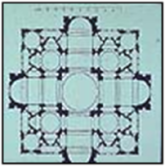 as the chief architect, Bramante’s plans envisaged a large square building, surmounted with a central dome and surrounded with bell towers and small domes at each corner. It was one of the greatest building projects yet conceived. Work was begun in 1506, but the old church had first to be removed, and before the new structure took shape Julius died (1513) and Bramante a year later. As we shall see, the design was then revised by Michelangelo (1512 H8), and it was the Swiss-
as the chief architect, Bramante’s plans envisaged a large square building, surmounted with a central dome and surrounded with bell towers and small domes at each corner. It was one of the greatest building projects yet conceived. Work was begun in 1506, but the old church had first to be removed, and before the new structure took shape Julius died (1513) and Bramante a year later. As we shall see, the design was then revised by Michelangelo (1512 H8), and it was the Swiss-
xxxxxBramante’s architectural achievements -
xxxxxThe Italian architect Donato Bramante moved to the city of Milan in the 1470s, where he was employed by Ludovico Sforza on a number of works. It was here that he worked with Leonardo da Vinci, trying to solve a structural problem in the city's cathedral. In 1493 he visited Florence to study the works of Brunelleschi, and six years later settled in Rome. Here he was inspired by the structures of ancient Rome, as can be seen in one of his finest works, the Tempietto, the first imitation of a circular, domed temple. Soon after 1503, the new pope, Julius II, appointed him the city's town planner, and in this capacity he improved roads and constructed large squares. His great opportunity came in 1506 when he was put in charge of the rebuilding of St. Peter’s church. His plan envisaged an impressive square building, surmounted with a central dome and surrounded with bell towers and domes at each corner. Work was begun in 1506, but before the site was even cleared, both Julius and Bramante were dead and the plan was redesigned, first by Michelangelo (1512 H8) and then by Carlo Maderno. Bramante also planned an ambitious extension to the Vatican Palace, but this never got off the drawing board.
xxxxxPope Julius II (1443-
xxxxxPope Julius II (1443-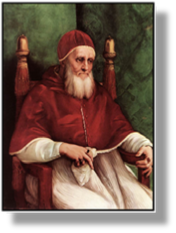 was elected Pope in 1503 after an eventful career in ecclesiastical politics, made the more so by his dogged opposition to the Borgias, the ruling family in Rome. Determined to restore the power and prestige of the papal states -
was elected Pope in 1503 after an eventful career in ecclesiastical politics, made the more so by his dogged opposition to the Borgias, the ruling family in Rome. Determined to restore the power and prestige of the papal states -
xxxxxBut despite this impressive record “on the battlefield”, as it were, Julius is best remembered to day for his patronage of the arts. No pope before or since has made such a significant contribution in this regard. It was he who, in 1505, made the decision to demolish Rome’s ancient basilica and replace it with the largest and finest church in the world (completed, in fact, in 1626). But quite apart from this and other architectural splendours achieved or planned in Rome -

Incidentally, it was Julius II who, in 1506, officially founded the Swiss Guard in order to provide a permanent corps of soldiers to protect the Pope.
xxxxxAs we have seen, while in Milan Bramante did much work for Ludovico Sforza. He was a member of the Sforza family which ruled the city for almost a century. The family earned the reputation of being despotic and extravagant, but some of its members were great patrons of the arts. Ludovico ruled Milan for close on nineteen years, but was driven from power by the French in 1500. A cunning ruler, he made Milan supreme among the city states, cultivating the friendship, among others, of Lorenzo the Magnificent, the Medici ruler of Florence, and the Borgia pope, Alexander VI. As a patron of the arts, he made Milan a leading centre of the Renaissance, attracting to his court, as we have seen, leading figures like Bramante and Leonardo da Vinci. He it was who commissioned Da Vinci’s Last Supper.
xxxxxAs we have seen, 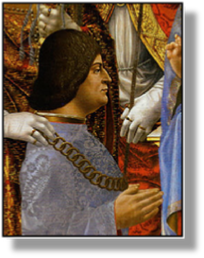 during his years in Milan, Bramante did a great deal of work for Ludovico Sforza (illustrated). He was a member of the Sforza family that ruled Milan for close on one hundred years. The founder of the “dynasty”, a prosperous farmer called Muzio Attendolo from the region of Ravenna, assumed the title Sforza (meaning “Force”) and ruled Milan until his death in 1424. His illegitimate son Francesco succeeded him, and became the Duke of Milan by marriage. The family earned a reputation for being despotic and extravagant. Galeazzo Maria, in particular, appointed Duke of Milan in 1466, -
during his years in Milan, Bramante did a great deal of work for Ludovico Sforza (illustrated). He was a member of the Sforza family that ruled Milan for close on one hundred years. The founder of the “dynasty”, a prosperous farmer called Muzio Attendolo from the region of Ravenna, assumed the title Sforza (meaning “Force”) and ruled Milan until his death in 1424. His illegitimate son Francesco succeeded him, and became the Duke of Milan by marriage. The family earned a reputation for being despotic and extravagant. Galeazzo Maria, in particular, appointed Duke of Milan in 1466, -
xxxxxLudovico,xGaleazzo’s younger brother, seized power in 1481 and was ruler of Milan until the French occupied the city in 1500. He then spent his last eight years imprisoned in France. Nicknamed “The Moor” because of his dark complexion, he proved a cunning leader who, taking advantage of conflicting rivalries, established Milan’s supremacy among the city states. Among those whose friendship he cultivated were Lorenzo the Magnificent, the Medici ruler of Florence, and the Borgia pope, Alexander VI. Unlike his brother, he did much to encourage scholarship and the arts. Under his patronage Milan became a leading centre of the Renaissance, attracting to its court leading figures like Bramante and Leonardo da Vinci. And it was Ludovico who commissioned Da Vinci’s Last Supper.
Acknowledgements
Bramante: self portrait, medal in bronze – Fitzwilliam Museum, Cambridge, England. Tempietto: date and photographer unknown. Julius II: by the Italian painter Sanzio Raphael (1483-
H7-


